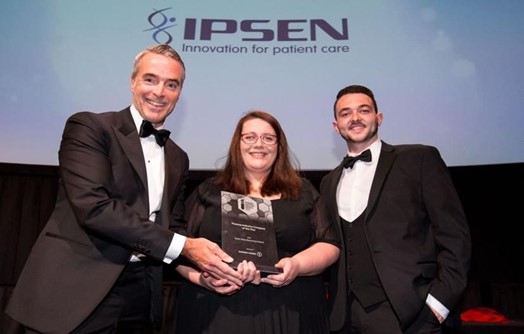The Scottish Medicines Consortium (SMC) accepts Ipsen’s IQIRVO® (elafibranor) for use in NHS Scotland – the first new medicine in nearly a decade for primary biliary cholangitis (PBC), a rare liver disease
Disclaimer: Intended for U.K. trade, medical and consumer media only
- Elafibranor is indicated for the treatment of PBC in combination with ursodeoxycholic acid (UDCA) in adults with an inadequate response to UDCA, or as monotherapy in adults unable to tolerate UDCA1
- Elafibranor is a first-in-class treatment for primary biliary cholangitis (PBC) – associated with severe fatigue and persistent, debilitating itch1,2,3
- PBC is a life-long condition that affects approximately 1,900 people in Scotland – nine in 10 of which are women4
- If inadequately treated, PBC can worsen over time and cause liver failure, leading to liver transplant and in rare cases, premature death5,6,7
- The SMC has also accepted Cabozantinib Ipsen as monotherapy for the treatment of hepatocellular carcinoma (HCC) in adults who have previously been treated with sorafenib, demonstrating Ipsen’s commitment to supporting patients with rare liver disease in Scotland8
LONDON, U.K., 7 April, 2025 – Ipsen (Euronext: IPN; ADR: IPSEY) announced today that the Scottish Medicines Consortium (SMC) has accepted elafibranor 80mg tablets for the treatment of PBC in combination with ursodeoxycholic acid (UDCA) in adults with an inadequate response to UDCA, or as monotherapy in adults unable to tolerate UDCA.9 This makes elafibranor the first new medicine for PBC to be accepted in nearly a decade, and the first in its class.10,11
“The SMC acceptance offers a significant option to patients and healthcare teams who may have been unable to slow the progression of PBC with existing treatments,” commented Professor John Dillon, Consultant Hepatologist and Professor of Hepatology and Gastroenterology at the University of Dundee. “It is an important new therapeutic agent and a welcome addition in managing a condition that is often debilitating for patients and life threatening for some.”
PBC is a rare, autoimmune, cholestatic liver disease. People with PBC in its earlier stages commonly experience severe fatigue and a persistent, debilitating itch, known as pruritus.2,3 The disease can worsen over time if inadequately treated, causing liver failure, leading to liver transplant and in rare cases, premature death.6,7
A lifelong disease, PBC impacts approximately 1,900 people in Scotland,4 affecting approximately nine women for every one man around the ages of 40-60 years.5,12 Despite the critical impact of the disease in its advanced staged, early symptoms and its typical age of diagnosis mean it can be mistaken for ageing or the menopause, impacting effective management.
A newly launched report from the PBC Foundation and Ipsen observed that patients in Scotland can experience a marked difference in diagnosis and support. The report calls for a national consensus pathway for the care of people with PBC in Scotland.
“PBC can have a massive impact on the lives of people living with the condition, but in some cases the symptoms aren’t being taken seriously” commented Mo Christie, Head of Patient Services at the Dunfermline-based PBC Foundation. “New treatment options not only help those living with PBC but may also raise awareness of the difficulties and stigma faced, such as liver conditions being associated with alcohol misuse. Our report into the PBC care pathway in Scotland calls for all patients to receive NHS-endorsed information at the point of diagnosis, to help tackle this misunderstanding and stigma.”
The disease causes a build-up of bile and toxins (cholestasis) and chronic inflammation, leading to irreversible fibrosis (scarring) of the liver and destruction of the bile ducts.7 While the causes of PBC are unknown, it is not caused by alcohol consumption but is associated with a combination of genetic risks and other environmental triggers.13
Elafibranor is a first-in-class, oral, once-daily peroxisome proliferator-activated receptor (PPAR) α/δ agonist.1,14 Activation of PPARα and PPARδ reduces bile toxicity, reduces inflammation and improves cholestasis.1
The SMC’s decision closely follows the approval of elafibranor by the National Institute for Health and Care Excellence (NICE) in October 2024,15 and is based on data from the Phase III ELATIVE trial published in the New England Journal of Medicine.14 In the ELATIVE trial 51% (55/108) of patients treated with elafibranor plus UDCA achieved the composite primary endpoint of cholestasis response* at week 52 compared to 4% (2/53) of patients in the placebo plus UDCA group.14
Secondary endpoints were normalisation of alkaline phosphatase (ALP) levels at week 52 and a change in pruritus intensity from baseline through week 52 and through week 24.14 The ELATIVE trial showed normalisation in ALP levels in only elafibranor-treated patients (15% for elafibranor plus UDCA (n=108) versus 0% for placebo plus UDCA (n=53)). A greater decrease in pruritus intensity, based on PBC Worst Itch Numeric Rating Scale (PBC WI-NRS), was observed in elafibranor-treated patients compared to placebo but this was not statistically significant.14
Additional patient-reported outcome measures were used to assess itch-related quality of life, including sleep and functioning, with greater improvements observed in patients treated with elafibranor compared to placebo.16 A post-hoc study of the ELATIVE trial found that 58% (14/24) of patients receiving elafibranor reported less time itching (improved duration) compared with 27% (3/11) on placebo at week 52,viii and 80% (20/25) of patients receiving elafibranor reported reduced or no sleep disturbance compared with 30% (3/10) on placebo.16
Elafibranor was generally well tolerated in the ELATIVE trial.14 Patients in the treatment group and the UDCA plus placebo group experienced similar percentages of adverse events, treatment-related adverse events, severe or serious adverse events or adverse events leading to discontinuation.14 Adverse events occurring in >10% of patients and more frequently on elafibranor versus placebo included abdominal pain (11%), diarrhoea (11%), nausea (11%), and vomiting (11%).14
The acceptance of elafibranor by the SMC follows the recent announcement (10 March 2025) that the SMC has recommended Ipsen’s cabozantinib as monotherapy for the treatment of HCC, a primary liver cancer which was responsible for 654 deaths in Scotland in 2023 and is the fastest rising cause of cancer death in the U.K.17,18 Cabozantinib is a protein kinase inhibitor that blocks mesenchymal epithelial transition factor (MET), vascular endothelial growth factor (VEGF) receptors and other tyrosine kinases including the GAS6 receptor (AXL).8
“The SMC’s recommendation of both elafibranor and cabozantinib demonstrates Ipsen’s commitment to bringing high value medicines to the U.K. to address unmet clinical and patient needs in rare liver diseases. These approvals are an important step in improving outcomes for patients and bringing parity of access across the U.K., following NICE approval of elafibranor in October last year”, said Dr David Montgomery, U.K. & Ireland Medical Director at Ipsen.
*Cholestasis response is defined as ALP <1.67 × upper limit of normal (ULN), total bilirubin ≤ ULN, and ALP decrease ≥15%.14 ALP is a biochemical marker and is used as a surrogate endpoint in PBC trials.19
ENDS
About IQIRVO® (elafibranor)
IQIRVO® – pronounced EYE-KER-VO – (elafibranor) is an oral, once-daily, peroxisome proliferator-activated receptor (PPAR) agonist. It is indicated for the treatment of PBC in combination with UDCA in adults with an inadequate response to UDCA, or as monotherapy in adults unable to tolerate UDCA.1 Elafibranor exerts an effect on PPARα and PPARδ. Activation of PPARα and PPARδ decreases bile toxicity and improves cholestasis by modulating bile acid synthesis, detoxification and transporters.1 Activation of PPARα and PPARδ also has anti-inflammatory effects by acting on different pathways.1 In October 2024, elafibranor was licensed for the treatment of PBC in combination with UDCA in adults with an inadequate response to UDCA, or as monotherapy in adults unable to tolerate UDCA, in the UK.20 Elafibranor was discovered and developed by GENFIT and Ipsen licensed the exclusive worldwide rights (except China, Hong Kong, Taiwan and Macau) to elafibranor from GENFIT in 2021.
About the Phase III ELATIVE trial
ELATIVE is a multinational, randomised double-blind, placebo-controlled Phase III clinical trial (n=161) that evaluated the efficacy and safety of elafibranor 80mg once daily plus UDCA (n=108) versus placebo plus UDCA (n=53). Elafibranor or placebo was administered in combination with UDCA in 95% of patients and as monotherapy in 5% of patients who were unable to tolerate UDCA. The results were published in the New England Journal of Medicine.14
- The ELATIVE trial demonstrated that elafibranor had a statistically significant treatment benefit with 51% (n=55/108) of patients on elafibranor achieving a cholestasis response compared with 4% (n=2/53) on the placebo arm, a placebo-adjusted treatment effect of 47% (95% CI 32, 57; p<0.0001). Cholestasis response was defined as ALP less than 1.67 ULN, an ALP decrease of greater than or equal to 15% from baseline and total bilirubin (TB) ≤ ULN at week 52.14
- The significant cholestasis response to elafibranor was further supported by data demonstrating reductions from baseline in ALP levels were sustained through week 52 and response was rapid, seen as early as week 4 in the elafibranor group.14
- ALP normalisation at week 52 was a key secondary endpoint with 15% (n=16/108) of elafibranor-treated patients demonstrating normalisation versus 0% placebo (95% CI 6, 23; p=0.002).14
- While elafibranor showed an observed improvement in pruritus change from baseline based on PBC Worst Itch Numeric Rating Scale score compared to placebo, the result was not statistically significant.14
- Additional patient-reported outcome measures (5-D itch and PBC-40 itch) were used to assess itch-related quality of life, including sleep and functioning, with greater improvements observed in patients treated with elafibranor compared to placebo.16
- 58% (n=14/24) of patients receiving elafibranor reported less time itching (improved duration) compared with 27% on placebo at week 52.16
- 80% (n=20/25) of patients receiving elafibranor reported reduced or no sleep disturbance compared with 30% on placebo.16
- The most common adverse reactions with elafibranor reported in ≥10% of study participants were abdominal pain (11%), diarrhoea (11%), nausea (11%) and vomiting (11%).14
About Cabozantinib Ipsen
The detailed recommendations for the use of Cabozantinib Ipsen from the Scottish Medicines Consortium (SMC) can be found here, and the Summary of Product Characteristics (SmPC) can be found here.
Cabozantinib is marketed by Exelixis, Inc. in the United States and by Takeda Pharmaceutical Company Limited in Japan. Ipsen has exclusive rights for the commercialisation of cabozantinib outside of the U.S. and Japan. Cabometyx (cabozantinib) is a registered trademark of Exelixis, Inc.
About Ipsen
We are a global biopharmaceutical company with a focus on bringing transformative medicines to patients in three therapeutic areas: Oncology, Rare Disease and Neuroscience.
Our pipeline is fuelled by external innovation and supported by nearly 100 years of development experience and global hubs in the U.S., France and the U.K. Our teams in more than 40 countries and our partnerships around the world enable us to bring medicines to patients in more than 80 countries.
Ipsen is listed in Paris (Euronext: IPN) and in the U.S. through a Sponsored Level I American Depositary Receipt program (ADR: IPSEY). For more information, visit ipsen.com.
Ipsen contacts
- Sam Howland, Head of Communications, U.K. & Ireland | sam.howland@ipsen.com
- Sally Bain, Senior Director, Global Media Relations | sally.bain@ipsen.com
External organisation media contacts
- Katy Thom, 90TEN Communications | katy.thom@90ten.co.uk
- Tom Clare-Ducler, 90TEN Communications| tom.clare-ducler@90ten.co.uk
Disclaimers and/or Forward-Looking Statements
Ipsen
The forward-looking statements, objectives and targets contained herein are based on Ipsen’s management strategy, current views and assumptions. Such statements involve known and unknown risks and uncertainties that may cause actual results, performance or events to differ materially from those anticipated herein. All of the above risks could affect Ipsen’s future ability to achieve its financial targets, which were set assuming reasonable macroeconomic conditions based on the information available today. Use of the words ‘believes’, ‘anticipates’ and ‘expects’ and similar expressions are intended to identify forward-looking statements, including Ipsen’s expectations regarding future events, including regulatory filings and determinations. Moreover, the targets described in this document were prepared without taking into account external-growth assumptions and potential future acquisitions, which may alter these parameters. These objectives are based on data and assumptions regarded as reasonable by Ipsen. These targets depend on conditions or facts likely to happen in the future, and not exclusively on historical data. Actual results may depart significantly from these targets given the occurrence of certain risks and uncertainties, notably the fact that a promising medicine in early development phase or clinical trial may end up never being launched on the market or reaching its commercial targets, notably for regulatory or competition reasons. Ipsen must face or might face competition from generic medicine that might translate into a loss of market share. Furthermore, the research and development process involves several stages each of which involves the substantial risk that Ipsen may fail to achieve its objectives and be forced to abandon its efforts with regards to a medicine in which it has invested significant sums. Therefore, Ipsen cannot be certain that favourable results obtained during preclinical trials will be confirmed subsequently during clinical trials, or that the results of clinical trials will be sufficient to demonstrate the safe and effective nature of the medicine concerned. There can be no guarantees a medicine will receive the necessary regulatory authorisation or that the medicine will prove to be commercially successful. If underlying assumptions prove inaccurate or risks or uncertainties materialise, actual results may differ materially from those set forth in the forward-looking statements. Other risks and uncertainties include but are not limited to, general industry conditions and competition; general economic factors, including interest rate and currency exchange rate fluctuations; the impact of pharmaceutical industry regulation and healthcare legislation; global trends toward healthcare cost containment; technological advances, new medicine and patents attained by competitors; challenges inherent in new-medicine development, including obtaining regulatory authorisation; Ipsen’s ability to accurately predict future market conditions; manufacturing difficulties or delays; financial instability of international economies and sovereign risk; dependence on the effectiveness of Ipsen’s patents and other protections for innovative medicines; and the exposure to litigation, including patent litigation, and/or regulatory actions. Ipsen also depends on third parties to develop and market some of its medicines which could potentially generate substantial royalties; these partners could behave in such ways which could cause damage to Ipsen’s activities and financial results. Ipsen cannot be certain that its partners will fulfil their obligations. It might be unable to obtain any benefit from those agreements. A default by any of Ipsen’s partners could generate lower revenues than expected. Such situations could have a negative impact on Ipsen’s business, financial position or performance. Ipsen expressly disclaims any obligation or undertaking to update or revise any forward-looking statements, targets or estimates contained in this press release to reflect any change in events, conditions, assumptions or circumstances on which any such statements are based, unless so required by applicable law. Ipsen’s business is subject to the risk factors outlined in its registration documents filed with the French Autorité des Marchés Financiers. The risks and uncertainties set out are not exhaustive and the reader is advised to refer to Ipsen’s latest Universal Registration Document, available on ipsen.com.
References
- Summary of Product Characteristics. IQIRVO. Available at: https://mhraproducts4853.blob.core.windows.net/docs/897b96eb88b3e7f0ff9fa5c13fc0f329db03ba51. Last accessed: April 2025.
- Mells GF, et al. 2013. Impact of Primary Biliary Cholangitis on Perceived Quality of Life: The UK-PBC National Study. Hepatology. 58: 273-283.
- C Levy, et al. 2023. Understanding the Experience of Patients with Primary Biliary Cholangitis and Pruritus. Abstract presented at ISPOR, 7-11 May 2023, Boston.
- PBC Foundation. PBC uncovered. Patients and clinicians set a new vision for primary biliary cholangitis in Scotland. Available at: https://www.healthandcare.scot/downloads/PBC in Scotland Report CERTIFIED.pdf. Last accessed April 2025
- Webb GJ, Ryan RP, Marshall TP, Hirschfield GM. The Epidemiology of UK Autoimmune Liver Disease Varies With Geographic Latitude. Clin Gastroenterol Hepatol. 2021 Dec;19(12):2587-2596. doi: 10.1016/j.cgh.2021.01.029. Epub 2021 Jan 22. PMID:33493696; PMCID: PMC8661127.
- NHS Blood and Transplant. Annual Report of Liver Transplantation Report for 2020/2021. Published 2021.
- Younossi ZM, et al. 2019. Diagnosis and Management of Primary Biliary Cholangitis. Am J Gastroenterol. 114(1):48–63
- Scottish Medicines Consortium (SMC). Cabozantinib (Cabozantinib Ipsen). Available at: https://scottishmedicines.org.uk/medicines-advice/cabozantinib-cabozantinib-ipsen-_abb-smc2754. Last accessed: April 2025
- Scottish Medicines Consortium (SMC). Elafibranor (Iqirvo). Available at: https://scottishmedicines.org.uk/medicines-advice/elafibranor-iqirvo-full-smc2714. Last accessed: April 2025
- Scottish Medicines Consortium (SMC). Obeticholic acid (Ocaliva®) is accepted for use within NHS Scotland. Available at: https://scottishmedicines.org.uk/medicines-advice/obeticholic-acid-ocaliva-fullsubmission-123217. Last accessed: April 2025
- Food and Drug Administration (FDA). Center for Drug Evaluation and Research. Advancing Health Through Innovation: New Drug Therapy Approvals 2024. Available at: https://www.fda.gov/media/184967/download. Last accessed: April 2025
- Trivella J, et al. Primary biliary cholangitis: Epidemiology, prognosis, and treatment. Hepatol Commun. 2023 Jun; 7(6): e0179.
- Gulamhusein AF, et al. Primary Biliary Cholangitis, DNA and Beyond: The Relative Contribution of Genes. Hepatology. 2018 Jul; 68(1): 19–21.
- Kowdley. K.V, et al. Efficacy and Safety of Elafibranor in Primary Biliary Cholangitis. NEJM. 2023. DOI: 10.1056/NEJMoa2306185.
- National Institution for Health and Care Excellence. Elafibranor for treating primary biliary cholangitis. Available at: https://www.nice.org.uk/guidance/indevelopment/gid-ta11378/documents. Last accessed: April 2025.
- Kremer AE, et al. 2024. Effect of elafibranor on pruritus in primary biliary cholangitis: Symptom severity and quality of life measurements from the phase III ELATIVE® trial. Journal of Hepatology Abstract Book. VOLUME 80 Suppl. 1 JUNE 2024. Available at: https://www.easlcongress.eu/wp-content/uploads/2024/06/Updated-1-EASL_2024_Abstract_version3-1.pdf Last accessed: April 2025.
- Liver Cancer UK. Statistics about liver cancer. Available at: https://livercanceruk.org/liver-cancer-information/statistics/ Last accessed: April 2025
- Cancer Research UK. Death rates from liver cancer double in the last 20 years. Available at: https://news.cancerresearchuk.org/2025/01/15/liver-cancer-death-rates-double-in-the-last-20-years/ Last accessed: April 2025
- EASL Clinical Practice Guidelines: The diagnosis and management of patients with primary biliary cholangitis Journal of Hepatology 2017 vol. 67 j 145–172.
- MHRA. Elafibranor approved as first medicine to treat adults with a rare liver disease known as primary biliary cholangitis. Available at: https://www.gov.uk/government/news/elafibranor-approved-as-first-medicine-to-treat-adults-with-a-rare-liver-disease-known-as-primary-biliary-cholangitis. Last accessed: April 2025.
IQV-GB-000159
October 2025







